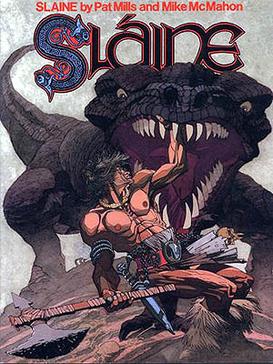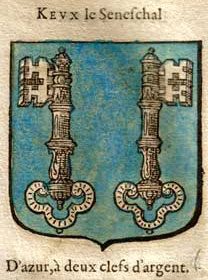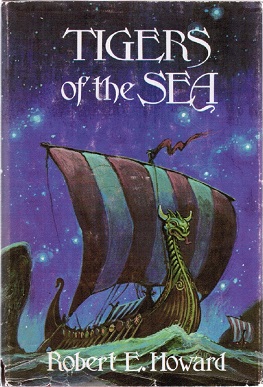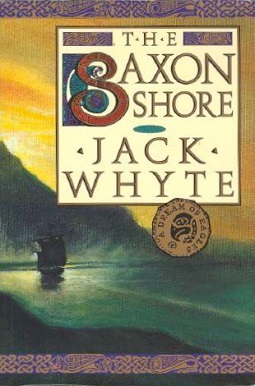
Ambrosius Aurelianus was a war leader of the Romano-British who won an important battle against the Anglo-Saxons in the 5th century, according to Gildas. He also appeared independently in the legends of the Britons, beginning with the 9th-century Historia Brittonum. Eventually, he was transformed by Geoffrey of Monmouth into the uncle of King Arthur, the brother of Arthur's father Uther Pendragon, as a ruler who precedes and predeceases them both. He also appears as a young prophet who meets the tyrant Vortigern; in this guise, he was later transformed into the wizard Merlin.

Hengist and Horsa are Germanic brothers said to have led the Angles, Saxons and Jutes in their supposed invasion of Britain in the 5th century. Tradition lists Hengist as the first of the Jutish kings of Kent.

The Kingdom of the West Saxons, also known as the Kingdom of Wessex, was an Anglo-Saxon kingdom in the south of Great Britain, from around 519 until England was unified around 927.

The Battle of Badon, also known as the Battle of Mons Badonicus, was a battle purportedly fought between Britons and Anglo-Saxons in Post-Roman Britain during the late 5th or early 6th century. It was credited as a major victory for the Britons, stopping the westward encroachment of the Anglo-Saxon kingdoms for a period.
Cynric was King of Wessex from 534 to 560. Everything known about him comes from the Anglo-Saxon Chronicle. There, he is stated to have been the son of Cerdic, who is considered the founder of the kingdom of Wessex. However, the Anglian King-list and parts of the West Saxon Genealogical Regnal List, instead says that Cynric was the son of Cerdic's son Creoda. Similarly, the paternal genealogy of Alfred the Great given in Asser's The Life of King Alfred, includes the name Creoda, while the account of the king's maternal ancestry in the same work calls Cynric son of Cerdic.

Cerdic is described in the Anglo-Saxon Chronicle as a leader of the Anglo-Saxon settlement of Britain, being the founder and first king of Wessex, reigning from around 519 to 534 AD. Subsequent kings of Wessex were each claimed by the Chronicle to descend in some manner from Cerdic. His origin, ethnicity, and even his very existence have been extensively disputed. However, though claimed as the founder of Wessex by later West Saxon kings, he would have been known to contemporaries as king of the Gewissae, a folk or tribal group. The first king of the Gewissae to call himself 'King of the West Saxons', was Cædwalla, in a charter of 686.

Guinevere, also often written in Modern English as Guenevere or Guenever, was, according to Arthurian legend, an early-medieval queen of Great Britain and the wife of King Arthur. First mentioned in popular literature in the early 12th century, nearly 700 years after the purported times of Arthur, Guinevere has since been portrayed as everything from a fatally flawed, villainous and opportunistic traitor to a noble and virtuous lady. Many records of the legend also feature the variably recounted story of her abduction and rescue as a major part of the tale.

Lancelot du Lac, also written as Launcelot and other variants, is a character in some versions of Arthurian legend where he is typically depicted as King Arthur's close companion and one of the greatest Knights of the Round Table. In the French-inspired Arthurian chivalric romance tradition, Lancelot is an orphaned son of King Ban of the lost kingdom of Benoic, raised in a fairy realm by the Lady of the Lake. A hero of many battles, quests and tournaments, and famed as a nearly unrivalled swordsman and jouster, Lancelot becomes the lord of the castle Joyous Gard and personal champion of Arthur's wife, Queen Guinevere, despite suffering from frequent and sometimes prolonged fits of madness. But when his adulterous affair with Guinevere is discovered, it causes a civil war that, once exploited by Mordred, brings an end to Arthur's kingdom.

Sláine is a comic hero that was first published in British magazine 2000 AD.

In Arthurian legend, Sir Kay is King Arthur's foster brother and later seneschal, as well as one of the first Knights of the Round Table. In later literature he is known for his acid tongue and bullying, boorish behaviour, but in earlier accounts he was one of Arthur's premier warriors. Along with Bedivere, with whom he is frequently associated, Kay is one of the earliest characters associated with Arthur. Kay's father is called Ector in later literature, but the Welsh accounts name him as Cynyr Ceinfarfog.

King Arthur is a 2004 historical adventure film directed by Antoine Fuqua and written by David Franzoni. It features an ensemble cast with Clive Owen as the title character, Ioan Gruffudd as Lancelot and Keira Knightley as Guinevere, along with Mads Mikkelsen, Joel Edgerton, Hugh Dancy, Ray Winstone, Ray Stevenson, Stephen Dillane, Stellan Skarsgård and Til Schweiger.
The Treason of the Long Knives is an account of a massacre of British Celtic chieftains by Anglo-Saxon soldiers at a peace conference on Salisbury Plain in the 5th century. The story is thought to be pseudohistorical as the only surviving records mentioning it are centuries later in the semi-mythological histories of the Historia Brittonum and the Historia Regum Britanniae. Though a popular cautionary tale in medieval Europe, there is no other historical evidence for The Treason of the Long Knives. Most historians interpret the story as a purely literary construction.

The Lantern Bearers is a historical novel for children by Rosemary Sutcliff, first published by Oxford in 1959 with illustrations by Charles Keeping. Set in Roman Britain during the 5th century, it is the story of a British Roman's life after the final withdrawal of Roman troops. Sutcliff won the annual Carnegie Medal from the Library Association, recognising the year's best children's book by a British subject.

The Winter King: A Novel of Arthur is the first novel of the Warlord Chronicles trilogy by Bernard Cornwell, originally published in the UK in 1995 by Penguin Group. The book is based on characters and plot elements from Arthurian myth, but considerably changed and re-worked.

Excalibur: A Novel of Arthur is a historical fiction novel by English writer Bernard Cornwell, first published in the UK in 1997. It is the third and final book in The Warlord Chronicles series, following The Winter King and Enemy of God. The trilogy tells the legend of King Arthur through the eyes of his follower Derfel Cadarn.
The Timeline of conflict in Anglo-Saxon Britain is concerned with the period of history from just before the departure of the Roman Army, in the 4th century, to just after the Norman Conquest in the 11th century.

Tigers of the Sea is a collection of fantasy short stories by Robert E. Howard about the pirate Cormac Mac Art, a Gael who joins a band of Danish Vikings during the reign of King Arthur.
Events from the 5th century in England. Note that many of these dates may only be approximate.

The Saxon Shore is a 1995 novel by Canadian writer Jack Whyte chronicling Caius Merlyn Britannicus's effort to return the baby Arthur to the colony of Camulod and the political events surrounding this. The book is a portrayal of the Arthurian Legend set against the backdrop of Post-Roman Britain's invasion by Germanic peoples. It is part of the A Dream of Eagles series, which attempts to explain the origins of the Arthurian legends against the backdrop of a historical setting. This is a deviation from other modern depictions of King Arthur such as Once and Future King and the Avalon series which rely much more on mystical and magical elements and less on the historical.
















